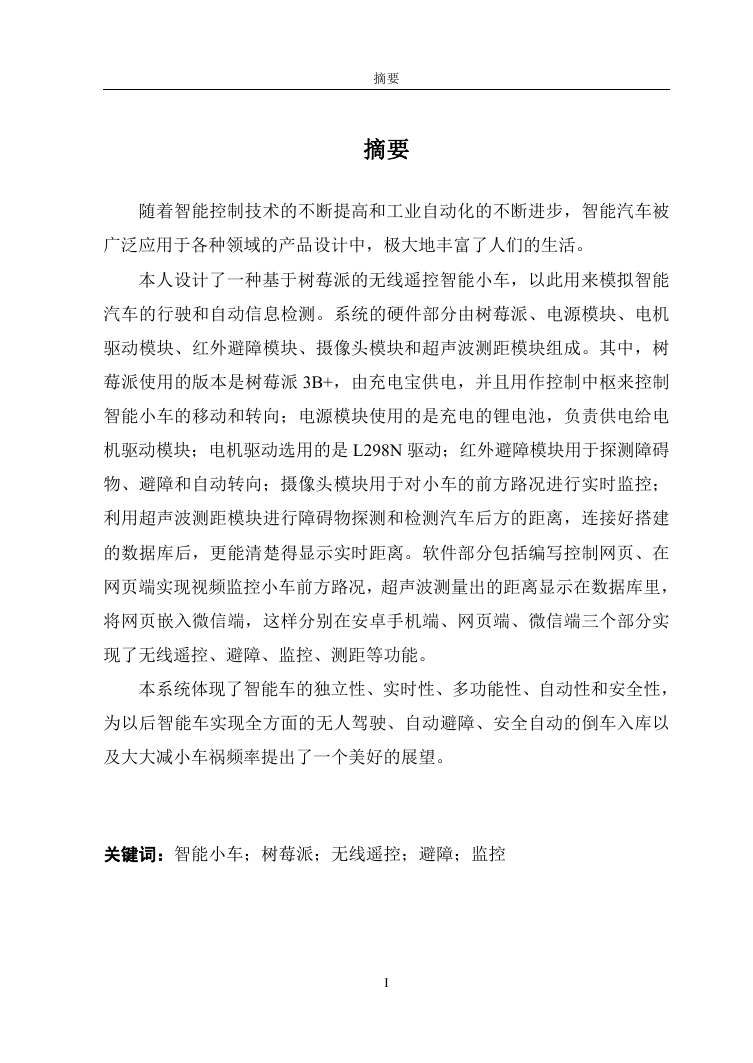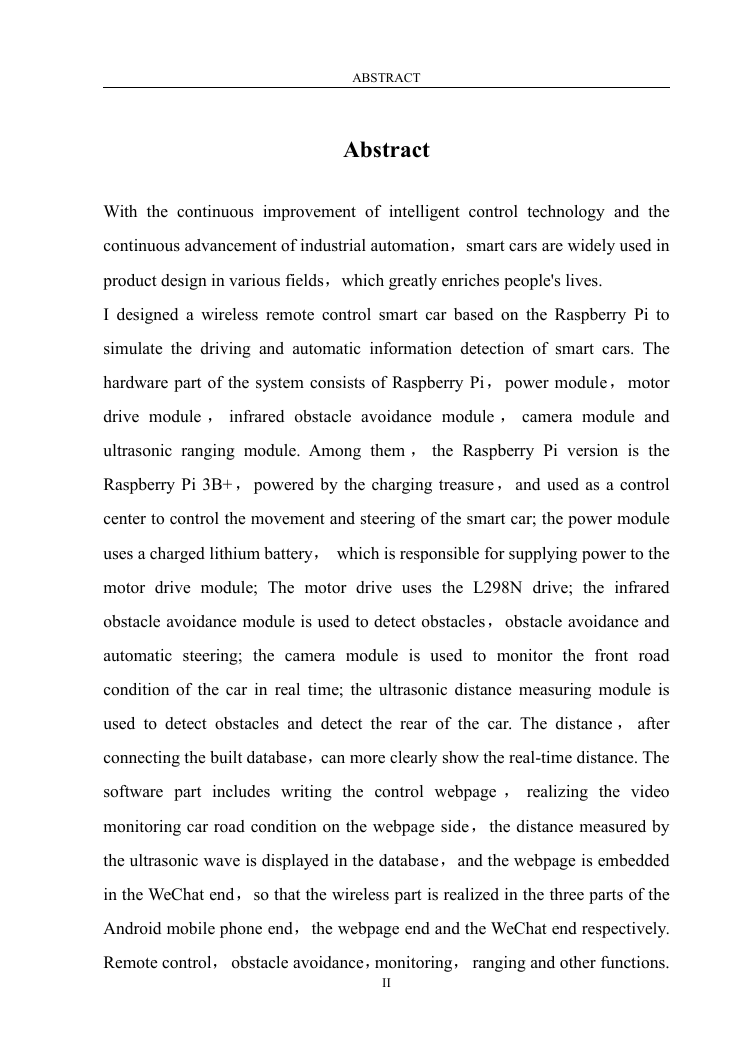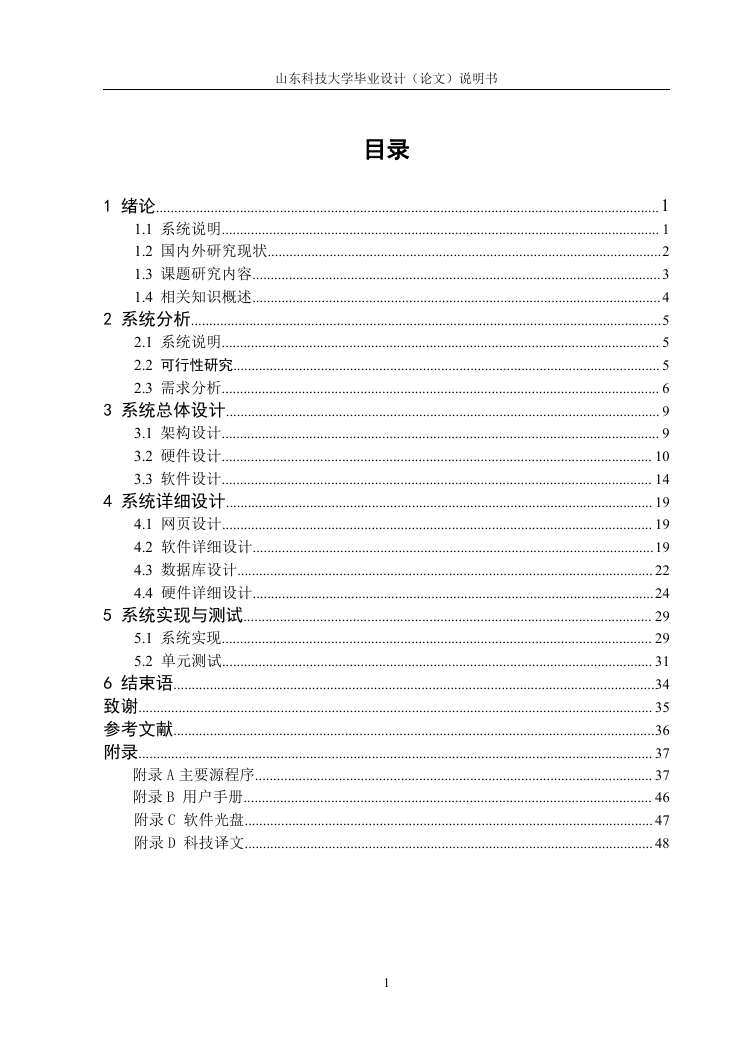毕业设计论文内容规范
(嵌入式系统)
信息工程系 编
19
�
�
摘要
摘要
随着智能控制技术的不断提高和工业自动化的不断进步,智能汽车被
广泛应用于各种领域的产品设计中,极大地丰富了人们的生活。
本人设计了一种基于树莓派的无线遥控智能小车,以此用来模拟智能
汽车的行驶和自动信息检测。系统的硬件部分由树莓派、电源模块、电机
驱动模块、红外避障模块、摄像头模块和超声波测距模块组成。其中,树
莓派使用的版本是树莓派 3B+,由充电宝供电,并且用作控制中枢来控制
智能小车的移动和转向;电源模块使用的是充电的锂电池,负责供电给电
机驱动模块;电机驱动选用的是 L298N 驱动;红外避障模块用于探测障碍
物、避障和自动转向;摄像头模块用于对小车的前方路况进行实时监控;
利用超声波测距模块进行障碍物探测和检测汽车后方的距离,连接好搭建
的数据库后,更能清楚得显示实时距离。软件部分包括编写控制网页、在
网页端实现视频监控小车前方路况,超声波测量出的距离显示在数据库里,
将网页嵌入微信端,这样分别在安卓手机端、网页端、微信端三个部分实
现了无线遥控、避障、监控、测距等功能。
本系统体现了智能车的独立性、实时性、多功能性、自动性和安全性,
为以后智能车实现全方面的无人驾驶、自动避障、安全自动的倒车入库以
及大大减小车祸频率提出了一个美好的展望。
关键词:智能小车;树莓派;无线遥控;避障;监控
I
�
ABSTRACT
Abstract
With the continuous improvement of intelligent control technology and the
continuous advancement of industrial automation,smart cars are widely used in
product design in various fields,which greatly enriches people's lives.
I designed a wireless remote control smart car based on the Raspberry Pi to
simulate the driving and automatic information detection of smart cars. The
hardware part of the system consists of Raspberry Pi,power module,motor
drive module , infrared obstacle avoidance module , camera module and
ultrasonic ranging module. Among them , the Raspberry Pi version is the
Raspberry Pi 3B+ ,powered by the charging treasure ,and used as a control
center to control the movement and steering of the smart car; the power module
uses a charged lithium battery, which is responsible for supplying power to the
motor drive module; The motor drive uses the L298N drive;
the infrared
obstacle avoidance module is used to detect obstacles,obstacle avoidance and
automatic steering;
the camera module is used to monitor the front road
condition of the car in real time; the ultrasonic distance measuring module is
used to detect obstacles and detect the rear of the car. The distance , after
connecting the built database,can more clearly show the real-time distance. The
software part
includes writing the control webpage , realizing the video
monitoring car road condition on the webpage side,the distance measured by
the ultrasonic wave is displayed in the database,and the webpage is embedded
in the WeChat end,so that the wireless part is realized in the three parts of the
Android mobile phone end,the webpage end and the WeChat end respectively.
Remote control,obstacle avoidance,monitoring,ranging and other functions.
II
�
ABSTRACT
The system embodies the independence,real-time,versatility,autonomy and
safety of the smart car. It realizes all-round unmanned driving , automatic
obstacle avoidance ,safe and automatic reversing into the garage and greatly
reduces the accident. The frequency presents a wonderful outlook.
Keywords:smart car; raspberry pie; wireless remote control; obstacle avoidance
III
�
�
山东科技大学毕业设计(论文)说明书
目录
1 绪论..........................................................................................................................................1
1.1 系统说明........................................................................................................................ 1
1.2 国内外研究现状............................................................................................................2
1.3 课题研究内容................................................................................................................3
1.4 相关知识概述................................................................................................................4
2 系统分析.................................................................................................................................5
2.1 系统说明........................................................................................................................ 5
2.2 可行性研究..................................................................................................................... 5
2.3 需求分析........................................................................................................................ 6
3 系统总体设计....................................................................................................................... 9
3.1 架构设计........................................................................................................................ 9
3.2 硬件设计...................................................................................................................... 10
3.3 软件设计...................................................................................................................... 14
4 系统详细设计..................................................................................................................... 19
4.1 网页设计...................................................................................................................... 19
4.2 软件详细设计..............................................................................................................19
4.3 数据库设计.................................................................................................................. 22
4.4 硬件详细设计..............................................................................................................24
5 系统实现与测试................................................................................................................ 29
5.1 系统实现...................................................................................................................... 29
5.2 单元测试...................................................................................................................... 31
6 结束语....................................................................................................................................34
致谢............................................................................................................................................. 35
参考文献....................................................................................................................................36
附录............................................................................................................................................. 37
附录 A 主要源程序............................................................................................................. 37
附录 B 用户手册................................................................................................................ 46
附录 C 软件光盘................................................................................................................ 47
附录 D 科技译文................................................................................................................ 48
1
�
绪论
1 绪论
1.1 课题背景
智能汽车也叫无人汽车,是一个集环境感知、规划决策和多等级辅助
驾驶等功能于一体的综合系统。它具有道路障碍自动识别、自动报警、自
动制动、自动保持安全距离、车速和巡航控制等功能。智能汽车的主要特
点是在复杂的道路情况下,能自动地操纵和驾驶车辆绕开障碍物并沿着预
定的道路(轨迹)行进。智能汽车在原有车辆系统的基础上增加了一些智
能化技术设备:
(1)计算机处理系统,主要对从摄像机获取的图像进行预处理,增强,分
析,识别等工作;
(2)视频监测系统,用于获取道路图像信息的监测然后传至终端;
(3)传感器设备,车速传感器用于获取当前车速,障碍物传感器用于获取
前后,后障碍等信息。
智能汽车也可以被理解为机器人的特殊情况,它随着机器人的发展而
发展;也是一种能够通过编程手段,添加上了新功能的智能移动机器人。
国内外机器人的发展有以下趋势:一方面,机器人越来越多地用于制
造业,它们被逐渐标准化,模块化,网络化和智能化,而且正在变得越来
越强大,它们的功能也越来越强大,而且正在朝着整套技术发展。另一方
面,机器人正在向非制造应用和更小的方向发展。
现如今,智能汽车也照着标准化,模块化,网络化和智能化发展,本文
设计的基于树莓派的智能小车就是对智能汽车的模拟,模拟智能汽车的一
部分功能,映射出智能汽车的优缺点。
2
�
















 2023年江西萍乡中考道德与法治真题及答案.doc
2023年江西萍乡中考道德与法治真题及答案.doc 2012年重庆南川中考生物真题及答案.doc
2012年重庆南川中考生物真题及答案.doc 2013年江西师范大学地理学综合及文艺理论基础考研真题.doc
2013年江西师范大学地理学综合及文艺理论基础考研真题.doc 2020年四川甘孜小升初语文真题及答案I卷.doc
2020年四川甘孜小升初语文真题及答案I卷.doc 2020年注册岩土工程师专业基础考试真题及答案.doc
2020年注册岩土工程师专业基础考试真题及答案.doc 2023-2024学年福建省厦门市九年级上学期数学月考试题及答案.doc
2023-2024学年福建省厦门市九年级上学期数学月考试题及答案.doc 2021-2022学年辽宁省沈阳市大东区九年级上学期语文期末试题及答案.doc
2021-2022学年辽宁省沈阳市大东区九年级上学期语文期末试题及答案.doc 2022-2023学年北京东城区初三第一学期物理期末试卷及答案.doc
2022-2023学年北京东城区初三第一学期物理期末试卷及答案.doc 2018上半年江西教师资格初中地理学科知识与教学能力真题及答案.doc
2018上半年江西教师资格初中地理学科知识与教学能力真题及答案.doc 2012年河北国家公务员申论考试真题及答案-省级.doc
2012年河北国家公务员申论考试真题及答案-省级.doc 2020-2021学年江苏省扬州市江都区邵樊片九年级上学期数学第一次质量检测试题及答案.doc
2020-2021学年江苏省扬州市江都区邵樊片九年级上学期数学第一次质量检测试题及答案.doc 2022下半年黑龙江教师资格证中学综合素质真题及答案.doc
2022下半年黑龙江教师资格证中学综合素质真题及答案.doc